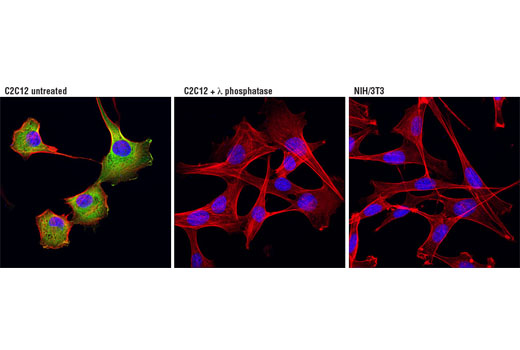
Western blot analysis of extracts from HeLa or HT-29 cells, untreated (-) or treated (+) with either UV (40 mJ/cm 2 with 30 min recovery) or anisomycin (25 μg/mL, 30 min), using Phospho-HSP27 (Ser82) (D1H2F6) XP ® Rabbit mAb.

Immunohistochemical analysis of paraffin-embedded human breast carcinoma, control (left) or λ phosphatase-treated (right), using Phospho-HSP27 (Ser82) (D1H2F6) XP ® Rabbit mAb.

Immunohistochemical analysis of paraffin-embedded mouse lung using Phospho-HSP27 (Ser82) (D1H2F6) XP ® Rabbit mAb.

Immunohistochemical analysis of paraffin-embedded HeLa cell pellets, control (left) or UV-treated (right), using Phospho-HSP27 (Ser82) (D1H2F6) XP ® Rabbit mAb.

Immunohistochemical analysis of paraffin-embedded human lung carcinoma using Phospho-HSP27 (Ser82) (D1H2F6) XP ® Rabbit mAb in the presence of control peptide (left) or antigen-specific peptide (right).

Immunohistochemical analysis of paraffin-embedded human prostate carcinoma using Phospho-HSP27 (Ser82) (D1H2F6) XP ® Rabbit mAb.

Confocal immunofluorescent analysis of C2C12 cells, untreated (left) or treated with λ phosphatase (middle), and NIH/3T3 cells (right) using Phospho-HSP27 (Ser82) (D1H2F6) XP ® Rabbit mAb (green). Actin filaments were labeled with DY-554 phalloidin (red). Blue pseudocolor = DRAQ5 ® #4084 (fluorescent DNA dye). Negative staining in NIH/3T3 cells is in agreement with the observation that NIH/3T3 cells do not express HSP27 under basal conditions (5,7).

Flow cytometric analysis of HeLa cells, untreated (blue) or UV-treated (green), using Phospho-HSP27 (Ser82) (D1H2F6) XP ® Rabbit mAb.







